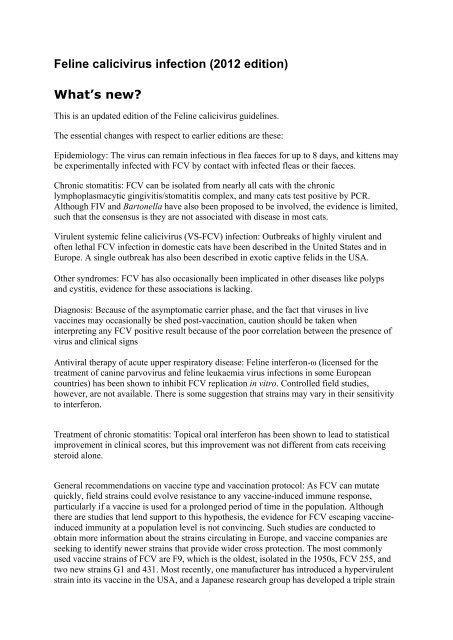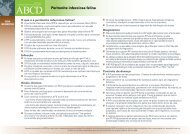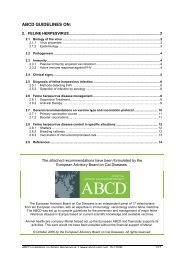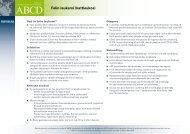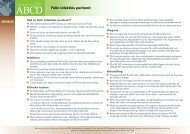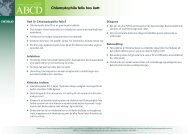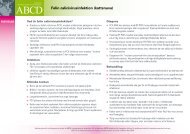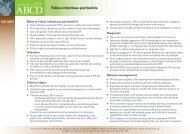Feline calicivirus infection - The European Advisory Board on Cat ...
Feline calicivirus infection - The European Advisory Board on Cat ...
Feline calicivirus infection - The European Advisory Board on Cat ...
Create successful ePaper yourself
Turn your PDF publications into a flip-book with our unique Google optimized e-Paper software.
field study, 20% of kittens at <strong>on</strong>ly six weeks of age had no detectable antibodies against awidely used vaccine strain (Daws<strong>on</strong> et al. 2001).Active immune resp<strong>on</strong>seVirus neutralising antibodies (VNA) appear by approximately seven days post <str<strong>on</strong>g>infecti<strong>on</strong></str<strong>on</strong>g>(Kahn et al., 1975). In general, antibody titres are higher than for FHV <str<strong>on</strong>g>infecti<strong>on</strong></str<strong>on</strong>g> and theirlevels correlate well with protecti<strong>on</strong> against homologous challenge (Povey & Ingersoll, 1975).<str<strong>on</strong>g>The</str<strong>on</strong>g>re is a c<strong>on</strong>siderable degree of antigenic variability am<strong>on</strong>gst FCV strains, but it wasc<strong>on</strong>cluded from studies of in vitro cross-reactivity that FCVs bel<strong>on</strong>g to a single serotype(Povey, 1974). Prior <str<strong>on</strong>g>infecti<strong>on</strong></str<strong>on</strong>g> with <strong>on</strong>e strain can significantly reduce the acute clinical signsup<strong>on</strong> exposure to a heterologous strain, and in some cases oral shedding may be reduced(Povey & Ingersoll, 1975; Knowles et al., 1991). In general, the level of heterologousprotecti<strong>on</strong> will depend <strong>on</strong> the virus strains involved.<strong>Cat</strong>s may be protected also in the absence of detectable VNA (Knowles et al., 1991; Poulet etal., 2005), suggesting a role for other immune mechanisms: indeed, cellular resp<strong>on</strong>ses havebeen dem<strong>on</strong>strated in vaccinated cats (Tham & Studdert, 1987). Also, FCV-specific IgG andIgA antibodies have been dem<strong>on</strong>strated in the saliva during the course of <str<strong>on</strong>g>infecti<strong>on</strong></str<strong>on</strong>g> (Knowleset al., 1991), although their significance in protecti<strong>on</strong> is unknown.Clinical signsFCV <str<strong>on</strong>g>infecti<strong>on</strong></str<strong>on</strong>g> can cause acute oral and upper respiratory signs but also has been associatedwith chr<strong>on</strong>ic stomatitis, which may be immune-mediated. Recently, a new syndrome, the“virulent systemic feline <str<strong>on</strong>g>calicivirus</str<strong>on</strong>g> (VS-FCV) disease” has been described.Acute oral and upper respiratory tract diseaseClinical findings may differ, depending <strong>on</strong> the virulence of the FCV strain c<strong>on</strong>cerned, <strong>on</strong> theage of the affected cats and <strong>on</strong> husbandry factors. While in some cases <str<strong>on</strong>g>infecti<strong>on</strong></str<strong>on</strong>g> issubclinical, in many others, there is a typical syndrome of lingual ulcerati<strong>on</strong> and a relativelymild acute respiratory disease. More severe signs can resemble the respiratory disease causedby FHV-1.Acute oral and upper respiratory disease signs are mainly seen in kittens. <str<strong>on</strong>g>The</str<strong>on</strong>g> incubati<strong>on</strong>period is 2 to 10 days (Hurley and Sykes, 2003). Oral ulcerati<strong>on</strong>s, sneezing and serous nasaldischarge are the main signs (Gaskell et al., 2006). Fever is also observed. Anorexia,sometimes accompanied by hypersalivati<strong>on</strong> due to oral erosi<strong>on</strong>s - located mainly <strong>on</strong> thet<strong>on</strong>gue - are usually much more prominent than the signs of rhinitis. <str<strong>on</strong>g>The</str<strong>on</strong>g>y usually resolveafter several days. In some severe cases, pneum<strong>on</strong>ia, manifested by dyspnoea, coughing, feverand depressi<strong>on</strong> can occur, particularly in young kittens.Chr<strong>on</strong>ic stomatitisFCV can be isolated from nearly all cats with the chr<strong>on</strong>ic lymphoplasmacyticgingivitis/stomatitis complex, and many cats test positive by PCR (Dowers 2010, Belgard2010). It has been suggested to be an immune-mediated reacti<strong>on</strong> to FCV (and potentiallyother) oral antigens and is characterised by a severe proliferative/ulcerative faucitis. However,the disease has not been reproduced experimentally (Knowles et al., 1991), and the exact role
of FCV remains unclear. Although FIV and Bart<strong>on</strong>ella have also been proposed to beinvolved, the evidence is limited ith (Glaus et al., 1997, Dowers et al 2011, Belgard 2010),such that the c<strong>on</strong>sensus is they are not associated with disease in most cats.Limping syndromeAn acute transient lameness with fever can be associated with FCV <str<strong>on</strong>g>infecti<strong>on</strong></str<strong>on</strong>g> (Ter Wee et al.,1997; Pedersen et al., 1983) and vaccinati<strong>on</strong>. In natural <str<strong>on</strong>g>infecti<strong>on</strong></str<strong>on</strong>g>, it occurs a few days orweeks after the acute oral or respiratory signs (Pedersen et al., 1983; Bennett et al., 1989).Virulent systemic feline <str<strong>on</strong>g>calicivirus</str<strong>on</strong>g> (VS-FCV) <str<strong>on</strong>g>infecti<strong>on</strong></str<strong>on</strong>g>Outbreaks of highly virulent and often lethal FCV <str<strong>on</strong>g>infecti<strong>on</strong></str<strong>on</strong>g> in domestic cats have beendescribed in the United States and in Europe (Pedersen et al., 2000; Coyne et al., 2006b,Reynolds et al 2009). A single outbreak has also been described in exotic captive felids in theUSA (Harris<strong>on</strong> et al 2007). <str<strong>on</strong>g>The</str<strong>on</strong>g> disease has been named “hemorrhagic-like fever” (Pedersenet al., 2000) and “highly virulent feline <str<strong>on</strong>g>calicivirus</str<strong>on</strong>g> disease” (Schorr-Evans et al., 2003). <str<strong>on</strong>g>The</str<strong>on</strong>g>causative virus strains are most comm<strong>on</strong>ly referred to as “virulent systemic feline <str<strong>on</strong>g>calicivirus</str<strong>on</strong>g>”(VS-FCV); however, this term is somewhat misleading as all FCV <str<strong>on</strong>g>infecti<strong>on</strong></str<strong>on</strong>g>s are systemic -but the disease caused by other FCV strains is usually local.<str<strong>on</strong>g>The</str<strong>on</strong>g> incubati<strong>on</strong> period in natural cases of VS-FCV <str<strong>on</strong>g>infecti<strong>on</strong></str<strong>on</strong>g> in cats exposed in hospitals isusually 1-5 days; in the home envir<strong>on</strong>ment it may extent up to 12 days (Hurley and Sykes,2003). <str<strong>on</strong>g>The</str<strong>on</strong>g> disease appears to be more severe in adults than kittens. Vaccinati<strong>on</strong> did notprotect cats against field <str<strong>on</strong>g>infecti<strong>on</strong></str<strong>on</strong>g>s (Hurley and Sykes, 2003), although experimentally, someprotecti<strong>on</strong> has been shown (Pedersen et al., 2000; Brunet et al., 2005). It is unknown whetherfthis is due to inherent characteristics of hypervirulent strains or simply that vaccine-“susceptible” strains are unlikely to cause outbreaks since vaccinati<strong>on</strong> is so widely practiced(Hurley, 2006; Pedersen et al., 2000).In c<strong>on</strong>trast to the comm<strong>on</strong> strains, VS-FCV causes systemic disease characterized by severesystemic inflammatory resp<strong>on</strong>se syndrome, disseminated intravascular coagulati<strong>on</strong>, multiorganfailure, and comm<strong>on</strong>ly death. Mortality is up to 67% (Foley et al., 2006).<str<strong>on</strong>g>The</str<strong>on</strong>g> clinical signs of this form of disease are variable. <str<strong>on</strong>g>The</str<strong>on</strong>g> initial findings are frequentlytypical of a severe acute upper respiratory tract disease. Characteristic signs are cutaneousoedema and ulcerative lesi<strong>on</strong>s <strong>on</strong> the skin and paws (Hurley and Sykes, 2003). Oedema islocated mainly <strong>on</strong> the head and limbs. Crusted lesi<strong>on</strong>s, ulcers and alopecia can be seen <strong>on</strong> thenose, lips, and ears, around the eyes and <strong>on</strong> the footpads. Some cats are jaundiced (e.g. due tohepatic necrosis, pancreatitis); some may show severe respiratory distress (e.g. due topulm<strong>on</strong>ary oedema). Thromboembolism and coagulopathy caused by DIC may be observedincluding petechiae, ecchymoses, epistaxis or bloody faeces (Hurley and Sykes, 2003; Coyneet al., 2006b).Other diseasesFCV has also occasi<strong>on</strong>ally been implicated in other diseases like polyps and cystitis, evidencefor these associati<strong>on</strong>s is lacking (Lars<strong>on</strong> 2011, Klose 2010)
Treatment of chr<strong>on</strong>ic stomatitisA full descripti<strong>on</strong> of the treatment of chr<strong>on</strong>ic stomatitis is bey<strong>on</strong>d the scope of theseguidelines. However, several modalities have been used to treat chr<strong>on</strong>ic ulceroproliferativestomatitis although c<strong>on</strong>trolled studies are lacking. Recommended opti<strong>on</strong>s depend <strong>on</strong> thedisease severity and stage and include antibiotics plus rigorous dental cleaning,corticosteroids and/or other immunosuppressant or immunomodulatory drugs (gold salts,clorambucil, thalidomide and cyclosporine; White et al., 1992; Addie et al., 2003; Vercelli etal., 2006; EBM grade IV) and full teeth extracti<strong>on</strong>s (Hennet, 1994; EBM grade III). Recently,anecdotal and clinical case reports have suggested the use of both feline interfer<strong>on</strong>-ω andhuman interfer<strong>on</strong>s to treat cats with chr<strong>on</strong>ic stomatitis associated with FCV shedding, byintra-lesi<strong>on</strong>al or combined systemic plus intralesi<strong>on</strong>al applicati<strong>on</strong> (Southerden & Gorrel,2007). Again, c<strong>on</strong>trolled studies <strong>on</strong> using that treatment are currently not available. Topicaloral interfer<strong>on</strong> has been shown to lead to statistical improvement, in clinical scores, but thisimprovement was not different from cats receiving steroid al<strong>on</strong>e (Hennet 2011; EBM gradeIV).General recommendati<strong>on</strong>s <strong>on</strong> vaccine type and vaccinati<strong>on</strong>protocolFCV <str<strong>on</strong>g>infecti<strong>on</strong></str<strong>on</strong>g> is ubiquitous and may induce severe disease. ABCD therefore recommendsthat all healthy cats should be vaccinated against FCV. Although vaccinati<strong>on</strong> provides goodprotecti<strong>on</strong> against acute oral and upper respiratory tract disease in most cases, it does notprevent cats from becoming infected and from shedding FCV afterwards (Radford et al.,2006). In additi<strong>on</strong>, there is currently no vaccine available in Europe that protects equally wellagainst all FCV field strains.Currently, FCV is combined with FHV-1 in divalent vaccines (<strong>on</strong>ly in some countries) or,more comm<strong>on</strong>ly, with additi<strong>on</strong>al other antigens. Both modified live and inactivated parenteralvaccines are available. Modified live intranasal vaccines are no l<strong>on</strong>ger available in Europe,but still current in the USA.FCV vaccines provide protecti<strong>on</strong> mainly by inducing humoral immunity (VN antibodies). Asthe virus can mutate quickly, field strains could evolve resistance to any vaccine-inducedimmune resp<strong>on</strong>se, particularly if a vaccine is used for a prol<strong>on</strong>ged period of time in thepopulati<strong>on</strong> (Lauritzen et al., 1997). Although there are some studies that lend support to thishypothesis (Addie et al 2008), the evidence for FCV escaping vaccine-induced immunity at apopulati<strong>on</strong> level is not yet c<strong>on</strong>vincing (Porter et al 2008). Such studies are c<strong>on</strong>ducted to obtainmore informati<strong>on</strong> about the strains circulating in Europe, and vaccine companies are seekingto identify newer strains that provide wider cross protecti<strong>on</strong> (Poulet et al., 2005). <str<strong>on</strong>g>The</str<strong>on</strong>g> mostcomm<strong>on</strong>ly used vaccine strains of FCV are F9, which is the oldest, isolated in the 1950s, FCV255, and two new strains G1 and 431 (Poulet et al., 2000; Poulet et al., 2005). Most recently,<strong>on</strong>e manufacturer has introduced a hypervirulent strain into its vaccine in the USA, however(Huang et al 2010), and a Japanese research group has developed a triple strain vaccine(Masubuchi 2010); however, at the time of writing these are not available in Europe. Somevaccine companies do not state the strain of virus used in their vaccine.In the absence of compelling published data, it is difficult to make a general recommendati<strong>on</strong>about which vaccine strain or strains to use. However, if disease is occurring in fullyvaccinated cats that are housed in groups, then changing to a different vaccine antigen mayoffer advantages.
<str<strong>on</strong>g>The</str<strong>on</strong>g> impact of vaccinati<strong>on</strong> <strong>on</strong> the shedding of field viruses is c<strong>on</strong>troversial, with some studiesshowing a moderate reducti<strong>on</strong> (Poulet et al., 2005, Jas et 2009) whilst others show thatvaccinati<strong>on</strong> might actually extend the period of virus shedding post <str<strong>on</strong>g>infecti<strong>on</strong></str<strong>on</strong>g>(Daws<strong>on</strong> et al.,1991; Pedersen & Hawkins, 1995). Live parenteral and intranasal FCV vaccine strains can beshed, although it seems rare (Pedersen & Hawkins, 1995; Radford et al., 1997, 2000, 2001;Coyne et al., 2007, Ruch Gallie 2011).Live vaccines retain some pathogenic potential and may induce disease if administeredincorrectly, e.g. when accidentally aerosolised or spilled <strong>on</strong> the skin and ingested (Daws<strong>on</strong> etal., 1993; Pedersen & Hawkins, 1995; Radford et al., 1997 and 2000). However, this appearsto be a rare event.<strong>Cat</strong>s that have recovered from caliciviral disease are probably not protected for life againstfurther episodes of disease, particularly those caused by different strains. <str<strong>on</strong>g>The</str<strong>on</strong>g>refore,vaccinati<strong>on</strong> of recovered, healthy cats is generally recommended, even in situati<strong>on</strong>s whereFCV is endemic.<str<strong>on</strong>g>The</str<strong>on</strong>g> value of serological tests in predicting protecti<strong>on</strong> is limited, because antibodies to the<str<strong>on</strong>g>calicivirus</str<strong>on</strong>g> strain used in a laboratory test may not necessarily protect against the strains thatthe cat will subsequently be exposed to in the field.Primary vaccinati<strong>on</strong> courseABCD recommends that all kittens should be vaccinated against FCV. Because MDA caninterfere with the resp<strong>on</strong>se to vaccinati<strong>on</strong>, the primary course of vaccinati<strong>on</strong> is usually startedat around nine weeks of age, although some vaccines are licensed for use at an earlier age.Kittens should receive a sec<strong>on</strong>d vaccinati<strong>on</strong> two to four weeks later, but not earlier than attwelve weeks of age. This protocol has been developed to ensure optimal protecti<strong>on</strong>.However, due to a l<strong>on</strong>ger persistence of MDA some kittens may fail to resp<strong>on</strong>d to thisprotocol (Daws<strong>on</strong> et al. 2001; EBM grade I). <str<strong>on</strong>g>The</str<strong>on</strong>g>refore, in high-risk situati<strong>on</strong>s, particularlywhere FCV has been shown to cause disease in vaccinated kittens, a third vaccinati<strong>on</strong> at 16weeks should be c<strong>on</strong>sidered. We recommend using the same brand for the entire primaryvaccinati<strong>on</strong> course.Older cats of uncertain FCV vaccinati<strong>on</strong> status should also receive two injecti<strong>on</strong>s with aninterval of two to four weeks, using vaccines c<strong>on</strong>taining the same virus strains. This applieseven if the vaccine c<strong>on</strong>tains modified live virus.Booster vaccinati<strong>on</strong>s<str<strong>on</strong>g>The</str<strong>on</strong>g> issue of recommended intervals between boosters is still c<strong>on</strong>troversial. However, based<strong>on</strong> positive study results published by several independent groups, ABCD recommends thatboosters should be given at triennial intervals to protect individual cats against FCV field<str<strong>on</strong>g>infecti<strong>on</strong></str<strong>on</strong>g>s (EBM grade II). <str<strong>on</strong>g>The</str<strong>on</strong>g>se cats are in low-risk situati<strong>on</strong>s, mainly indoor-<strong>on</strong>ly cats withlittle or no c<strong>on</strong>tact to others. However, owners should be made aware that as time since thelast vaccinati<strong>on</strong> increases, the degree of protecti<strong>on</strong> would decrease. <strong>Cat</strong>s in crowded high-risksituati<strong>on</strong>s (e.g. boarding catteries) should be revaccinated at yearly intervals. For other cats,an informed decisi<strong>on</strong> should be made <strong>on</strong> the basis of a risk-benefit analysis.
<str<strong>on</strong>g>The</str<strong>on</strong>g> ABCD recommends a single injecti<strong>on</strong> if the interval since the last vaccinati<strong>on</strong> is less thanthree years. If the interval exceeds three years, two vaccinati<strong>on</strong>s would ensure optimalprotecti<strong>on</strong>. Boosters using FCV vaccines from different manufacturers are acceptable.<str<strong>on</strong>g>The</str<strong>on</strong>g> ABCD appreciates that single-comp<strong>on</strong>ent FCV vaccines are currently unavailable.Annual boosters that protect against other antigens may in practice entail more frequentboosters than triennially.Disease c<strong>on</strong>trol in specific situati<strong>on</strong>sSheltersFCV is often a problem in cat shelters. Management to limit or even prevent virustransmissi<strong>on</strong> is as important as vaccinati<strong>on</strong> in c<strong>on</strong>trol. Shelter design and management shouldbe aimed at avoiding cross <str<strong>on</strong>g>infecti<strong>on</strong></str<strong>on</strong>g> of cats. <strong>Cat</strong>s should be housed individually unless theyare known to originate from the same household. Dogs and cats should be housed separately,and flea c<strong>on</strong>trol should be implemented to minimise the risk of transmissi<strong>on</strong> of FCV and otherdiseases.If acute respiratory disease occurs in a shelter, identificati<strong>on</strong> of the agent involved (withdifferentiati<strong>on</strong> of FCV from FHV-1, Chlamydophila felis, Bordetella br<strong>on</strong>chiseptica, andMycoplasma spp.) may be useful in deciding <strong>on</strong> the appropriate preventative measures. Incase of an FCV outbreak, it should be c<strong>on</strong>sidered that FCV can persist in the envir<strong>on</strong>ment forabout <strong>on</strong>e m<strong>on</strong>th and is resistant to many comm<strong>on</strong> disinfectants. Effective substances includesodium hypochlorite (5% bleach diluted at 1:32), potassium peroxy-m<strong>on</strong>osulfate, chlorinedioxide and commercial products that have been approved for their virucidal activity.New healthy cats should be vaccinated as so<strong>on</strong> as possible. Modified live virus vaccines arepreferred in shelters because of the earlier <strong>on</strong>set of protecti<strong>on</strong>.Breeding catteriesFCV can be a major problem for cat breeders. Infecti<strong>on</strong> most often appears as upperrespiratory disease in young kittens, typically at around 4-8 weeks as MDA wanes. Disease insuch young kittens can be severe and frequently involves all the kittens in the litter; somekittens may die. Vaccinati<strong>on</strong> of the queen will not prevent virus shedding, but may bebeneficial in ensuring that the kittens benefit from higher levels of MDA through thecolostrum and milk, providing protecti<strong>on</strong> for the first m<strong>on</strong>th or so of life.Booster vaccinati<strong>on</strong>s should take place prior to mating. Vaccinati<strong>on</strong> during pregnancy is notrecommended. Modified live virus vaccines are not licensed for use in pregnant cats and ifc<strong>on</strong>sidered at all, an inactivated vaccine must be used.Queens should kitten in isolati<strong>on</strong>, and in order to avoid the risk of exposure to potentialcarrier cats, the litter should not mix with other cats until it has been fully vaccinated. Earlyvaccinati<strong>on</strong> should be c<strong>on</strong>sidered for litters from queens that had infected litters previously orfor which there is c<strong>on</strong>cern of <str<strong>on</strong>g>infecti<strong>on</strong></str<strong>on</strong>g>. <str<strong>on</strong>g>The</str<strong>on</strong>g> earliest age for which FCV vaccines are licensedis six weeks, but vaccinati<strong>on</strong> may be c<strong>on</strong>sidered even earlier in kittens deemed to be at risk.When levels of MDA may be too low to protect, vaccinati<strong>on</strong> should be repeated every twoweeks until the primary vaccinati<strong>on</strong> course is c<strong>on</strong>cluded at twelve weeks.
When all other c<strong>on</strong>trol strategies have failed, early weaning into isolati<strong>on</strong> from around fourweeks of age is an alternative approach to protect kittens against <str<strong>on</strong>g>infecti<strong>on</strong></str<strong>on</strong>g> from their mothers.Vaccinati<strong>on</strong> of immunocompromised catsVaccines cannot generate optimum protecti<strong>on</strong> in animals with compromised immunefuncti<strong>on</strong>, such as deficient nutriti<strong>on</strong>, genetic and acquired, viral immunodeficiencies, systemicdisease, c<strong>on</strong>current administrati<strong>on</strong> of immunosuppressive drugs and envir<strong>on</strong>mental stress.Efforts should be made to protect immunocompromised cats from exposure to infectiousagents and to correct these c<strong>on</strong>diti<strong>on</strong>s prior to vaccinati<strong>on</strong>; if this cannot be assured,vaccinati<strong>on</strong> should be performed nevertheless and repeated after the animal has fullyrecovered. Based <strong>on</strong> safety c<strong>on</strong>siderati<strong>on</strong>s, ABCD recommends inactivated vaccines in thesecircumstances. Modified live FCV vaccines should not be used in immunocompromisedindividuals, as the failure to c<strong>on</strong>trol replicati<strong>on</strong> of the vaccine virus could lead to clinicalsigns.FIV positive catsVaccinati<strong>on</strong> of FIV-infected cats is c<strong>on</strong>troversial. FIV-infected cats are capable of mountingimmune resp<strong>on</strong>ses to administered antigens except during the terminal phase of <str<strong>on</strong>g>infecti<strong>on</strong></str<strong>on</strong>g>, butalso primary immune resp<strong>on</strong>ses may be delayed or diminished (Daws<strong>on</strong> et al., 1991; Reubelet al., 1994; Foley et al., 2003; EBM grade III). FCV vaccinati<strong>on</strong> was less effective in catsshortly after experimental <str<strong>on</strong>g>infecti<strong>on</strong></str<strong>on</strong>g> with FIV, as compared to uninfected cats, and vaccinati<strong>on</strong>might enhance l<strong>on</strong>g-term shedding of FCV (Daws<strong>on</strong> et al., 1991).Immune stimulati<strong>on</strong> of FIV-infected lymphocytes in vitro promotes FIV replicati<strong>on</strong>. In vivo,vaccinati<strong>on</strong> of chr<strong>on</strong>ically infected cats with a synthetic peptide was associated with adecrease in the CD4+/CD8+ ratio (Lehmann et al.1992; Reubel et al., 1994). <str<strong>on</strong>g>The</str<strong>on</strong>g>refore, apotential trade-off to protecti<strong>on</strong> from FCV-related disease is the progressi<strong>on</strong> of FIV <str<strong>on</strong>g>infecti<strong>on</strong></str<strong>on</strong>g>as a result of increased virus producti<strong>on</strong>. Thus, <strong>on</strong>ly FIV cats with a high risk of exposure toinfectious agents that are clinically healthy or in a stable medical c<strong>on</strong>diti<strong>on</strong> should bevaccinated, and <strong>on</strong>ly killed vaccines used.FeLV-positive catsFeLV-infected cats should be kept indoors and isolated, to avoid exposure to FCV, but also todiminish the likelihood of retrovirus transmissi<strong>on</strong> to other cats. Asymptomatic FeLV-infectedcats should be vaccinated against FCV. Although there is no evidence that FeLV-infected catsare at increased risk of vaccine-induced disease from residual virulence of modified-life virusvaccines, killed vaccines are preferable. FeLV-infected cats may not mount adequate immuneresp<strong>on</strong>ses to rabies vaccines and perhaps neither to other vaccines. Protecti<strong>on</strong> of FeLVinfectedcats may therefore not be comparable to that achieved in uninfected cats, and morefrequent vaccinati<strong>on</strong> should be c<strong>on</strong>sidered.Chr<strong>on</strong>ic diseaseExcepti<strong>on</strong>s from the general rule to vaccinate <strong>on</strong>ly healthy animals apply for cats with chr<strong>on</strong>icillness, where vaccinati<strong>on</strong> may sometimes be necessary. Manufacturers evaluate vaccinesafety and efficacy in healthy animals and accordingly, vaccines are labelled for use inhealthy animals <strong>on</strong>ly. N<strong>on</strong>etheless, cats with stable chr<strong>on</strong>ic c<strong>on</strong>diti<strong>on</strong>s such as renal disease,diabetes mellitus or hyperthyroidism should receive vaccines at the same frequency as healthycats. In c<strong>on</strong>trast, cats with acute illness, debilitati<strong>on</strong>, or high fever should not be vaccinated.
In cats with chr<strong>on</strong>ic stomatitis and FCV <str<strong>on</strong>g>infecti<strong>on</strong></str<strong>on</strong>g>, administrati<strong>on</strong> of modified live FCVvaccine is best avoided (Pedersen et al., 1995; EBM grade IV).<strong>Cat</strong>s receiving corticosteroids or other immunosuppressive drugsIn cats under corticosteroid treatment, vaccinati<strong>on</strong> should be c<strong>on</strong>sidered carefully. Depending<strong>on</strong> dosage and durati<strong>on</strong>, corticosteroids may cause functi<strong>on</strong>al suppressi<strong>on</strong> of cell-mediatedimmune resp<strong>on</strong>ses in particular. In dogs, corticosteroids do not hamper effectiveimmunizati<strong>on</strong> if given for short periods of time at low to moderate doses (Nara et al., 1979),but the effect of corticosteroids <strong>on</strong> vaccine efficacy in cats is not known. Hence the use ofcorticosteroids and/or other immunosuppressants at the time of vaccinati<strong>on</strong> should beavoided.ReferencesAbd-Eldaim M, Potgieter L & Kennedy M (2005). Genetic analysis of feline <str<strong>on</strong>g>calicivirus</str<strong>on</strong>g>esassociated with a hemorrhagic-like disease. J Vet Diagn Invest, 17:420-9.Addie DD, Radford A, Yam PS & Taylor DJ (2003). Cessati<strong>on</strong> of feline calicvirus sheddingcoinciding with resoluti<strong>on</strong> of chr<strong>on</strong>ic gingivostomatitis in a cat. J Small Anim Pract,44(4):172-6.Addie D, Poulet H, Golder MC, McD<strong>on</strong>ald M, Brunet S, Thibault JC, Hosie MJ (2008).Ability of antibodies to two new caliciviral vaccine strains to neutralise feline <str<strong>on</strong>g>calicivirus</str<strong>on</strong>g>isolates from the UK. Vet Rec 163(12):355-7.Bannasch MJ & Foley JE (2005). Epidemiologic evaluati<strong>on</strong> of multiple respiratory pathogensin cats in animal shelters. J <str<strong>on</strong>g>Feline</str<strong>on</strong>g> Med Surg, 7:109-19.Belgard S, Truyen U, Thibault JC, Sauter-Louis C, Hartmann K (2010). Prelevance of feline<str<strong>on</strong>g>calicivirus</str<strong>on</strong>g>, feline immunodeficiency virus, feline leukemia virus, feline herpesvirus andBart<strong>on</strong>ella henselae in cats with chr<strong>on</strong>ic gingivostomatitis. Berl Munch Tierarztl Wochenschr123(9-10):369-76.Bennett D, Gaskell RM, Mills A, Knowles J, Carter S & McArdle F (1989). Detecti<strong>on</strong> offeline <str<strong>on</strong>g>calicivirus</str<strong>on</strong>g> antigens in the joints of infected cats. Vet Rec, 124(13):329-32.Binns SH, Daws<strong>on</strong> S, Speakman AJ, Cuevas LE, Hart CA, Gaskell CJ, Morgan KL & GaskellRM (2000). A study of feline upper respiratory tract disease with reference to prevalence andrisk factors for <str<strong>on</strong>g>infecti<strong>on</strong></str<strong>on</strong>g> with feline <str<strong>on</strong>g>calicivirus</str<strong>on</strong>g> and feline herpesvirus. J <str<strong>on</strong>g>Feline</str<strong>on</strong>g> Med Surg,2:123-33.Brunet S, Jas D, David F, Bublot M & Poulet H. (2005). <str<strong>on</strong>g>Feline</str<strong>on</strong>g> <str<strong>on</strong>g>calicivirus</str<strong>on</strong>g>: vaccinati<strong>on</strong>sagainst virulent strains. In Comparative and emerging virus <str<strong>on</strong>g>infecti<strong>on</strong></str<strong>on</strong>g>s of dogs and cats.C<strong>on</strong>ference of the <str<strong>on</strong>g>European</str<strong>on</strong>g> Society of Veterinary Virology 2005, Liverpool.Clay S, Maherchandani S, Malik YS & Goyal SM (2006). Survival <strong>on</strong> uncomm<strong>on</strong> fomites offeline <str<strong>on</strong>g>calicivirus</str<strong>on</strong>g>, a surrogate of noroviruses. Am J Infect C<strong>on</strong>trol, 34:41-3.Coutts AJ, Daws<strong>on</strong> S, Willoughby K & Gaskell RM (1994). Isolati<strong>on</strong> of feline respiratoryviruses from clinically healthy cats at UK cat shows. Vet Rec, 135:555-556.
Coyne KP, Daws<strong>on</strong> S, Radford AD, Cripps PJ, Porter CJ, McCracken CM & Gaskell RM(2006a). L<strong>on</strong>g term analysis of feline <str<strong>on</strong>g>calicivirus</str<strong>on</strong>g> prevalence and viral shedding patterns innaturally infected col<strong>on</strong>ies of domestic cats. Vet Microbiol, 118(1-2):12-25.Coyne KP, Gaskell RM, Daws<strong>on</strong> S, Porter CJ & Radford AD (2007). Evoluti<strong>on</strong>arymechanisms of persistence and diversificati<strong>on</strong> of a <str<strong>on</strong>g>calicivirus</str<strong>on</strong>g> within endemically infectednatural host populati<strong>on</strong>s. J Virol, 81(4): 1961-1971.Coyne KP, J<strong>on</strong>es BRD, Kipar A, Chantrey J, Porter CJ, Barber PJ, Daws<strong>on</strong> S, Gaskell RM &Radford AD (2006b). Lethal outbreak of a disease associated with feline <str<strong>on</strong>g>calicivirus</str<strong>on</strong>g> <str<strong>on</strong>g>infecti<strong>on</strong></str<strong>on</strong>g>in cats. Vet Rec, 158: 544-550.Daws<strong>on</strong> S, D Bennett, SD Carter, M Bennett, J Meanger, PC Turner, MJ Carter, I Milt<strong>on</strong> &RM Gaskell (1994). Acute arthritis of cats associated with feline <str<strong>on</strong>g>calicivirus</str<strong>on</strong>g> <str<strong>on</strong>g>infecti<strong>on</strong></str<strong>on</strong>g>. Res VetSci, 56:133-143.Daws<strong>on</strong> S, McArdle F, Bennett M, Carter M, Milt<strong>on</strong> IP, Turner P, Meanger J & Gaskell RM(1993). Typing of feline <str<strong>on</strong>g>calicivirus</str<strong>on</strong>g> isolates from different clinical groups by virusneutralisati<strong>on</strong> tests. Vet Rec, 133(1):13-7.Daws<strong>on</strong> S, NR Smyth, M Bennett, RM Gaskell, CM McCracken, A Brown & CJ Gaskell(1991). Effect of primary-stage feline immunodeficiency virus <str<strong>on</strong>g>infecti<strong>on</strong></str<strong>on</strong>g> <strong>on</strong> subsequent feline<str<strong>on</strong>g>calicivirus</str<strong>on</strong>g> vaccinati<strong>on</strong> and challenge in cats. AIDS, 5:747-750.Daws<strong>on</strong> S, Willoughby K, Gaskell RM, Woog G & WCK Chalmers (2001). A field trial toassess the effect of vaccinati<strong>on</strong> against feline herpesvirus, feline <str<strong>on</strong>g>calicivirus</str<strong>on</strong>g> and felinepanleukopenia virus in 6-week-old kittens. J <str<strong>on</strong>g>Feline</str<strong>on</strong>g> Med Surg 3:17-22.Di Martino B, Di Rocco C, Ceci C, Marsilio F (2009). Characterizati<strong>on</strong> of a strain of feline<str<strong>on</strong>g>calicivirus</str<strong>on</strong>g> isolated from a dog faecal sample. Vet Microbiol. 139(1-2):52-7.Doultree JC, Druce JD, Birch CJ, Bowden DS, Marshall JA (1999). Inactivati<strong>on</strong> of feline<str<strong>on</strong>g>calicivirus</str<strong>on</strong>g>, a Norwalk virus surrogate. J Hosp Infect, 41:51-7.Dowers KL, Hawley JR, Brewer MM, Morris AK, Radecki SV, Lappin MR (2010).Associati<strong>on</strong> of Bart<strong>on</strong>ella species, feline <str<strong>on</strong>g>calicivirus</str<strong>on</strong>g>, and feline herpesvirus 1 <str<strong>on</strong>g>infecti<strong>on</strong></str<strong>on</strong>g> withgingivostomatitis in cats. J <str<strong>on</strong>g>Feline</str<strong>on</strong>g> Med Surg 12(4):314-21.Duizer E, Bijkerk P, Rockx B, De Groot A, Twisk F, Koopmans M (2004). Inactivati<strong>on</strong> of<str<strong>on</strong>g>calicivirus</str<strong>on</strong>g>es. Appl Envir<strong>on</strong> Microbiol, 70:4538-43.Foley J, K Hurley, PA Pesavento, A Poland & NC Pedersen (2006). Virulent systemic feline<str<strong>on</strong>g>calicivirus</str<strong>on</strong>g> <str<strong>on</strong>g>infecti<strong>on</strong></str<strong>on</strong>g>: local cytokine modulati<strong>on</strong> and c<strong>on</strong>tributi<strong>on</strong> of viral mutants. J. <str<strong>on</strong>g>Feline</str<strong>on</strong>g>Med Surg, 8: 55-61.Foley JE, CM Leutenegger, JS Dumler, NC Pedersen & JE Madigan (2003). Evidence formodulated immune resp<strong>on</strong>se to Anaplasma phagocytophila sensu lato in cats with FIVinducedimmunosuppressi<strong>on</strong>. Comp Immunol Micribiol Infect, 26:103-113.Fult<strong>on</strong> RW, Burge LJ (1985). Susceptibility of feline herpesvirus 1 and a feline <str<strong>on</strong>g>calicivirus</str<strong>on</strong>g> tofeline interfer<strong>on</strong> and recombinant human leukocyte interfer<strong>on</strong>s. Antimicrob AgentsChemother, 28(5):698-9.
Gaskell R & S Daws<strong>on</strong> (1998). <str<strong>on</strong>g>Feline</str<strong>on</strong>g> respiratory disease. In: Infectious diseases of the dogand cat, Greene CE (Ed), WB Saunders Company, Philadelphia (USA), 97-106.Gaskell RM, S Daws<strong>on</strong> S & AD Radford (2006). <str<strong>on</strong>g>Feline</str<strong>on</strong>g> respiratory disease. In: Infectiousdiseases of the dog and cat, Greene CE (Ed), Saunders Elsevier, 145-154.Geissler K, K Schneider & U Truyen (2002). Mapping neutralizing and n<strong>on</strong>-neutralizingepitopes <strong>on</strong> the capsid protein of feline <str<strong>on</strong>g>calicivirus</str<strong>on</strong>g>. J Vet Med B Infect Dis Vet Public Health,49(1):55-60.Geissler K, Schneider K, Platzer G, Truyen B, Kaaden OR, Truyen U (1997). Genetic andantigenic heterogeneity am<strong>on</strong>g feline <str<strong>on</strong>g>calicivirus</str<strong>on</strong>g> isolates from distinct disease manifestati<strong>on</strong>s.Virus Res, 48(2):193-206.Glaus T, R Hofmann-Lehman, C Greene, B Glaus, C Wolfensberger & H Lutz (1997).Seroprevalence of bart<strong>on</strong>ella henselae Infecti<strong>on</strong> and correlati<strong>on</strong> with disease status in cats inSwitzerland. J Clin Microb 35 (11): 2883-2885.Glenn M, Radford AD, Turner PC, Carter M, Lowery D, DeSilver DA, Meanger J, Baulch-Brown C, Bennett M, Gaskell RM (1999). Nucleotide sequence of UK and Australian isolatesof feline <str<strong>on</strong>g>calicivirus</str<strong>on</strong>g> (FCV) and phylogenetic analysis of FCVs. Vet Microbiol, 67(3):175-93.Gore TC, Lakshmanan N, Williams JR, Jirjis FF, Chester ST, Duncan KL, Coyne MJ, LumMA, Sterner FJ (2006). Three-year durati<strong>on</strong> of immunity in cats following vaccinati<strong>on</strong> againstfeline rhinotracheitis virus, feline <str<strong>on</strong>g>calicivirus</str<strong>on</strong>g>, and feline panleukopenia virus. Vet <str<strong>on</strong>g>The</str<strong>on</strong>g>r;7(3):213-22.Green KY, T Ando, MS Balayan, T Berke, IN Clarke, MK Estes, DO Mats<strong>on</strong>, S Nakata, JDNeill, MJ Studdert & HJ Thiel (2000). Tax<strong>on</strong>omy of the <str<strong>on</strong>g>calicivirus</str<strong>on</strong>g>es. J Infect Dis, 181 Suppl2:S 322-30.Harris<strong>on</strong> TM, Sikarskie J, Kruger J, Wise A, Mullaney TP, Kiupel M, Maes RK (2007).Systemic <str<strong>on</strong>g>calicivirus</str<strong>on</strong>g> epidemic in captive exotic felids. J Zoo Wildl Med 38(2):292-9.Hashimoto M, F Roerink, Y Tohya & M Mochizuki (1999). Genetic analysis of the RNApolymerase gene of <str<strong>on</strong>g>calicivirus</str<strong>on</strong>g>es from dogs and cats. J Vet Med Sci, 61:603-8.Helps CR, P Lait, A Damhuis, U Bjornehammar, D Bolta, C Brovida, L Chabanne, HEgberink, G Ferrand, A F<strong>on</strong>tb<strong>on</strong>ne, MG Pennisi, T Gruffydd-J<strong>on</strong>es, D Gunn-Moore, KHartmann, H Lutz, E Malandain, K Mostl, C Stengel, DA Harbour & EA Graat (2005).Factors associated with upper respiratory tract disease caused by feline herpesvirus, feline<str<strong>on</strong>g>calicivirus</str<strong>on</strong>g>, Chlamydophila felis and Bordetella br<strong>on</strong>chiseptica in cats: experience from 218<str<strong>on</strong>g>European</str<strong>on</strong>g> catteries. Vet Rec, 156:669-73.Helps CR, P Lait, S Tasker, D Harbour (2002). Melting curve analysis of feline <str<strong>on</strong>g>calicivirus</str<strong>on</strong>g>isolated detected by real-time reverse transcripti<strong>on</strong> PCR J Virol Methods, 106 (2): 241-244.Hennet P (1994). Results of period<strong>on</strong>tal and extracti<strong>on</strong> treatment in cats with gingivostomatitis.In Proceedings of the World Veterinary Dental C<strong>on</strong>gress, 49.Hennet PR, Camy GA, McGahie DM, Albouy MV (2011). Comparative efficacy of arecombinant feline interfer<strong>on</strong> omega in refractory cases of <str<strong>on</strong>g>calicivirus</str<strong>on</strong>g>-positive cats withcaudal stomatitis: a randomised, multi-centre, c<strong>on</strong>trolled, double-blind study in 39 cats. J<str<strong>on</strong>g>Feline</str<strong>on</strong>g> Med Surg ;13(8):577-87.
Huang C, Hess J, Gill M, Hustead D (2010). A dual-strain feline <str<strong>on</strong>g>calicivirus</str<strong>on</strong>g> vaccinestimulates broader cross-neutralizati<strong>on</strong> antibodies than a single-strain vaccine and lessensclinical signs in vaccinated cats when challenged with a homologous feline <str<strong>on</strong>g>calicivirus</str<strong>on</strong>g> strainassociated with virulent systemic disease. J <str<strong>on</strong>g>Feline</str<strong>on</strong>g> Med Surg 12(2):129-37.Hurley KF & ES Sykes (2003). Update <strong>on</strong> feline <str<strong>on</strong>g>calicivirus</str<strong>on</strong>g>: new trends. Vet Clin North AmSmall Anim Prac, 33(4): 759 – 772.Hurley KF (2006). Virulent Calicivirus <str<strong>on</strong>g>infecti<strong>on</strong></str<strong>on</strong>g> in cats. In Proceedings American College ofVeterinary Internal Medicine C<strong>on</strong>gress 2006.Jas D, Aeberlé C, Lacombe V, Guiot AL, Poulet H (2009). Onset of immunity in kittens aftervaccinati<strong>on</strong> with a n<strong>on</strong>-adjuvanted vaccine against feline panleucopenia, feline <str<strong>on</strong>g>calicivirus</str<strong>on</strong>g> andfeline herpesvirus. Vet J 182(1):86-93.Johns<strong>on</strong> R.P & RC Povey (1983). Transfer and decline of maternal antibody to feline<str<strong>on</strong>g>calicivirus</str<strong>on</strong>g>. Can Vet J, 24: 6.Johns<strong>on</strong> RP (1992). Antigenic change in feline <str<strong>on</strong>g>calicivirus</str<strong>on</strong>g> during persistent <str<strong>on</strong>g>infecti<strong>on</strong></str<strong>on</strong>g>. Can JVet Res, 56:326-330.Kahn DE, EA Hoover, & JL Bittle (1975). Inducti<strong>on</strong> of immunity to feline caliciviral disease.Infect Immunol, 11: 1003.Klose TC, MacPhail CM, Schultheiss PC, Rosychuk RA, Hawley JR, Lappin MR (2010).Prevalence of select infectious agents in inflammatory aural and nasopharyngeal polyps fromclient-owned cats. J <str<strong>on</strong>g>Feline</str<strong>on</strong>g> Med Surg 12(10):769-74.Knowles JO, F McArdle, S Daws<strong>on</strong>, SD Carter, CJ Gaskell & RM Gaskell (1991). Studies <strong>on</strong>the role of feline <str<strong>on</strong>g>calicivirus</str<strong>on</strong>g> in chr<strong>on</strong>ic stomatitis in cats. Vet. Microbiol. 27: 205-219.Kreutz LC, RP Johns<strong>on</strong> & BS Seal (1998). Phenotypic and genotypic variati<strong>on</strong> of feline<str<strong>on</strong>g>calicivirus</str<strong>on</strong>g> during persistent <str<strong>on</strong>g>infecti<strong>on</strong></str<strong>on</strong>g> of cats. Vet Microbiol, 59:229-236.Lappin MR, J Andrews, D Simps<strong>on</strong> & WA Jensen (2002). Use of serologic tests to predictresistance to feline herpesvirus 1, feline <str<strong>on</strong>g>calicivirus</str<strong>on</strong>g>, and feline parvovirus <str<strong>on</strong>g>infecti<strong>on</strong></str<strong>on</strong>g> in cats. JAm Vet Med Assoc, 220 (1):38-42.Lars<strong>on</strong> J, Kruger JM, Wise AG, Kaneene JB, Miller R, Fitzgerald SD, Kiupel M, Maes RK(2011). Nested case-c<strong>on</strong>trol study of feline <str<strong>on</strong>g>calicivirus</str<strong>on</strong>g> viruria, oral carriage, and serumneutralizing antibodies in cats with idiopathic cystitis. J Vet Intern Med 25(2):199-205.Lauritzen A, O Jarrett & M Sabara (1997). Serological analysis of feline <str<strong>on</strong>g>calicivirus</str<strong>on</strong>g> isolatesfrom the United States and United Kingdom. Vet Microbiol, 56 55-63.Lehman R, B v<strong>on</strong> Beust, E Niederer, MA C<strong>on</strong>drau, W Fierz, A Aubert, CD Ackley, MDCooper, MB Tompkins & H Lutz (1992). Immunizati<strong>on</strong>-induced decrease of theCDA+:CD8+ ratio in cats experimentally infected with feline immunodeficiency virus. VetImmunol Immunopathol 35:199-214.Marsilio F, BD Martino, N Decaro & C Bu<strong>on</strong>avoglia (2005) A novel nested PCR for thediagnosis of <str<strong>on</strong>g>calicivirus</str<strong>on</strong>g> <str<strong>on</strong>g>infecti<strong>on</strong></str<strong>on</strong>g>s in the cat Vet Microbiol, 105: 1-7.
Martella V, A Pratelli, M Gentile, D Bu<strong>on</strong>avoglia, N Decaro, P Fiorente & C Bu<strong>on</strong>avoglia(2002). Analysis of the capsid protein gene of a feline-like <str<strong>on</strong>g>calicivirus</str<strong>on</strong>g> isoalted from a dog. VetMicrobiol, 85:315-322.Masubuchi K, Wakatsuki A, Iwamoto K, Takahashi T, Kokubu T, Shimizu M (2010).Immunological and genetic characterizati<strong>on</strong> of feline <str<strong>on</strong>g>calicivirus</str<strong>on</strong>g>es used in the development ofa new trivalent inactivated vaccine in Japan. J Vet Med Sci 72(9):1189-94.McCann KB, Lee A, Wan J, Roginski H, Coventry MJ (2003). <str<strong>on</strong>g>The</str<strong>on</strong>g> effect of bovinelactoferrin and lactoferricin B <strong>on</strong> the ability of feline <str<strong>on</strong>g>calicivirus</str<strong>on</strong>g> (a norovirus surrogate) andpoliovirus to infect cell cultures. J Appl Microbiol, 95(5):1026-33.Mencke N, Vobis M, Mehlhorn H, D Haese J, Rehagen M, Mangold-Gehring S, Truyen U(2009). Transmissi<strong>on</strong> of feline <str<strong>on</strong>g>calicivirus</str<strong>on</strong>g> via the cat flea (Ctenocephalides felis). ParasitolRes 105(1):185-9.Mochizuki M, Nakatani H, Yoshida M (1994). Inhibitory effects of recombinant felineinterfer<strong>on</strong> <strong>on</strong> the replicati<strong>on</strong> of feline enteropathogenic viruses in vitro. Vet Microbiol, 39(1-2):145-52.Nara PL, S Krakowka & TE Powers (1979) Effects of prednisol<strong>on</strong>e <strong>on</strong> the development ofimmune resp<strong>on</strong>se to canine distemper virus in beagle pups. Am J Vet Res, 40(12):1742-7.Ohe K, Sakai S, Sunaga F, Murakami M, Kiuchi A, Fukuyama M, Furuhata K, Hara M, SomaT, Ishikawa Y, and Taneno A (2006). Detecti<strong>on</strong> of <str<strong>on</strong>g>Feline</str<strong>on</strong>g> <str<strong>on</strong>g>calicivirus</str<strong>on</strong>g> (FCV) from Vaccinated<strong>Cat</strong>s and Phylogenetic Analysis of its Capsid Genes. Vet Res Commun, 30(3):293-305.Ohe K, Takahashi T, Hara D, Hara M (2008). Sensitivity of FCV to recombinant felineinterfer<strong>on</strong> (rFeIFN). Vet Res Commun 32(2):167-74.Ossiboff RJ, Sheh A, Shott<strong>on</strong> J, Pesavento PA, Parker JS (2007). <str<strong>on</strong>g>Feline</str<strong>on</strong>g> <str<strong>on</strong>g>calicivirus</str<strong>on</strong>g>es (FCVs)isolated from cats with virulent systemic disease possess in vitro phenotypes distinct fromthose of other FCV isolates. J Gen Virol, 88:506-27.Pedersen NC (1987). <str<strong>on</strong>g>Feline</str<strong>on</strong>g> <str<strong>on</strong>g>calicivirus</str<strong>on</strong>g>. In: Virus <str<strong>on</strong>g>infecti<strong>on</strong></str<strong>on</strong>g>s of carnivores. Appel MJ (Ed),Elsevier Science Publishers BV, New York, 339-346.Pedersen NC & KF Hawkins (1995). Mechanisms for persistence of acute and chr<strong>on</strong>ic feline<str<strong>on</strong>g>calicivirus</str<strong>on</strong>g> <str<strong>on</strong>g>infecti<strong>on</strong></str<strong>on</strong>g>s in the face of vaccinati<strong>on</strong>. Vet Microbiol, 47(1-2): 141-156.Pedersen NC, JB Elliott, A Glasgow, A Poland & K Keel (2000). An isolated epizootic ofhemorrhagic-like fever in cats caused by a novel and highly virulent strain of feline<str<strong>on</strong>g>calicivirus</str<strong>on</strong>g>. Vet Microbiol, 73:281-300.Pedersen NC, Laliberte L, Ekman S (1983). A transient febrile "limping" syndrome of kittenscaused by two different strains of feline <str<strong>on</strong>g>calicivirus</str<strong>on</strong>g>. <str<strong>on</strong>g>Feline</str<strong>on</strong>g> Practice, 13:26-35.Pesavento PA, NJ MacLachlan, L Dillard-Telm, CK Grant & KF Hurley (2004). Pathologic,immunohistochemical, and electr<strong>on</strong> microscopic findings in naturally occurring virulentsystemic feline <str<strong>on</strong>g>calicivirus</str<strong>on</strong>g> <str<strong>on</strong>g>infecti<strong>on</strong></str<strong>on</strong>g> in cats. Vet Pathol, 41:257-63.Porter CJ, Radford AD, Gaskell RM, Ryvar R, Coyne KP, Pinchbeck GL, Daws<strong>on</strong> S (2008).Comparis<strong>on</strong> of the ability of feline <str<strong>on</strong>g>calicivirus</str<strong>on</strong>g> (FCV) vaccines to neutralise a panel of currentUK FCV isolates. J <str<strong>on</strong>g>Feline</str<strong>on</strong>g> Med Surg 10(1):32-40.
Poulet H, S Brunet, M Soulier, V Leroy, S Goutebroze & G Chappuis (2000). Comparis<strong>on</strong>between acute oral/respiratory and chr<strong>on</strong>ic stomatitis/gingivitis isolates of feline <str<strong>on</strong>g>calicivirus</str<strong>on</strong>g>:pathogenicity, antigenic profile and cross-neutralisati<strong>on</strong> studies. Arch Virol, 145(2):243-61.Poulet H, S Brunet, V Leroy & G Chappuis (2005). Immunisati<strong>on</strong> with a combinati<strong>on</strong> of twocomplementary feline <str<strong>on</strong>g>calicivirus</str<strong>on</strong>g> strains induces a broad cross-protecti<strong>on</strong> against heterologouschallenges. Vet Microbiol,. 106(1-2):17-31.Povey C & J Ingersoll (1975). Cross-protecti<strong>on</strong> am<strong>on</strong>g feline calicviruses. Infect Immun,11:877-885.Povey RC (1974). Serological relati<strong>on</strong>ships am<strong>on</strong>g feline <str<strong>on</strong>g>calicivirus</str<strong>on</strong>g>es. Infect Immun,10:1307-1314.Povey RC (1978). Effect of orally administered ribavirin <strong>on</strong> experimental feline <str<strong>on</strong>g>calicivirus</str<strong>on</strong>g><str<strong>on</strong>g>infecti<strong>on</strong></str<strong>on</strong>g> in cats. Am J Vet Res. 39(8):1337-41.Radford AD M Bennett, F McArdle, S Daw<strong>on</strong>, PC Turner, MA Glenn & RM Gaskell (1997).<str<strong>on</strong>g>The</str<strong>on</strong>g> use of sequence analysis of a feline <str<strong>on</strong>g>calicivirus</str<strong>on</strong>g> (FCV) hypervariable regi<strong>on</strong> in theepidemiological investigati<strong>on</strong> of FCV related disease and vaccine failures. Vaccine, 15: 1451-1458.Radford AD, Daws<strong>on</strong> S, Ryvar R, Coyne K, Johns<strong>on</strong> DR, Cox MB, Acke EF, Addie DD,Gaskell RM (2003). High genetic diversity of the immunodominant regi<strong>on</strong> of the feline<str<strong>on</strong>g>calicivirus</str<strong>on</strong>g> capsid gene in endemically infected cat col<strong>on</strong>ies. Virus Genes, 27:145-55.Radford AD, K Willoughby, S Daws<strong>on</strong>, C McCracken & RM Gaskell (1999). <str<strong>on</strong>g>The</str<strong>on</strong>g> capsidgene of feline <str<strong>on</strong>g>calicivirus</str<strong>on</strong>g> c<strong>on</strong>tains linear B-cell epitopes in both variable and c<strong>on</strong>servedregi<strong>on</strong>s. J Virol, 73:8496-502.Radford AD, PCTurner, M Bennett, F McArdle, S Daws<strong>on</strong>, MA Glenn, RA Williams & RMGaskell (1998). Quasispecies evoluti<strong>on</strong> of a hypervariable regi<strong>on</strong> of the feline <str<strong>on</strong>g>calicivirus</str<strong>on</strong>g>capsid gene in cell culture and in persistently infected cats. J Gen Virol, 79:1-10.Radford AD, S Daw<strong>on</strong>, C Wharmby, R Ryvar & RM Gaskell (2000). Comparis<strong>on</strong> ofserological and sequence-based methods for typing feline <str<strong>on</strong>g>calicivirus</str<strong>on</strong>g> isolates from vaccinefailures. Vet Rec, 146: 117-123.Radford AD, S Daws<strong>on</strong>, KP Coyne, CJ Porter & RM Gaskell (2006). <str<strong>on</strong>g>The</str<strong>on</strong>g> challenge for thenext generati<strong>on</strong> of feline <str<strong>on</strong>g>calicivirus</str<strong>on</strong>g> vaccines. Vet Microbiol. 117(1):14-8.Radford AD, Sommerville L, Ryvar R, Cox MB, Johns<strong>on</strong> DR, Daws<strong>on</strong> S, Gaskell RM(2001). Endemic <str<strong>on</strong>g>infecti<strong>on</strong></str<strong>on</strong>g> of a cat col<strong>on</strong>y with a feline <str<strong>on</strong>g>calicivirus</str<strong>on</strong>g> closely related to an isolateused in live attenuated vaccines. Vaccine, 19:4358-4362.Reubel GH, GA Dean, JW George, JE Barlough & NC Pedersen (1994). Effects of incidental<str<strong>on</strong>g>infecti<strong>on</strong></str<strong>on</strong>g>s and immune activati<strong>on</strong> <strong>on</strong> disease progressi<strong>on</strong> in expermimentally felineimmunodeficiency virus-infected cats. J Acq Immun Defic Syndrome, 7:1003-1015.Reynolds BS, Poulet H, Pingret JL, Jas D, Brunet S, Lemeter C, Etievant M, Boucraut-Baral<strong>on</strong> C (2009). A nosocomial outbreak of feline <str<strong>on</strong>g>calicivirus</str<strong>on</strong>g> associated virulent systemicdisease in France. J <str<strong>on</strong>g>Feline</str<strong>on</strong>g> Med Surg 11(8):633-44.
Roerink F, M Hashimoto, Y Tohya & M Mochizuki (1999). Genetic analysis of a canine<str<strong>on</strong>g>calicivirus</str<strong>on</strong>g>: evidence for a new clade of animal <str<strong>on</strong>g>calicivirus</str<strong>on</strong>g>es. Vet Microbiol, 69:69-72.Ruch-Gallie RA, Veir JK, Hawley JR, Lappin MR (2011). Results of molecular diagnosticassays targeting feline herpesvirus-1 and feline <str<strong>on</strong>g>calicivirus</str<strong>on</strong>g> in adult cats administered modifiedlive vaccines. J <str<strong>on</strong>g>Feline</str<strong>on</strong>g> Med Surg 13(8):541-5.Scansen BA, AG Wise, JM Kruger, PJ Venta & RK Maes (2004). Evaluati<strong>on</strong> of a p30 genebasedreal-time reverse transcriptase polymerase chain reacti<strong>on</strong> assay for detecti<strong>on</strong> of feline<str<strong>on</strong>g>calicivirus</str<strong>on</strong>g>es. J Vet Intern Med, 18(1): 135-138.Schorr-Evans EM, Poland A, Johns<strong>on</strong> WE & Pedersen NC (2003). An epizootic of highlyvirulent feline <str<strong>on</strong>g>calicivirus</str<strong>on</strong>g> disease in a hospital setting in New England. J <str<strong>on</strong>g>Feline</str<strong>on</strong>g> Med Surg,5(4):217-26.Scott FW & Geissinger CM (1997). Durati<strong>on</strong> of immunity in cats vaccinated with aninactivated feline panleukopenia, herpesvirus and <str<strong>on</strong>g>calicivirus</str<strong>on</strong>g> vaccine. <str<strong>on</strong>g>Feline</str<strong>on</strong>g> Practice, 25:12-19.Scott FW & Geissinger CM (1999). L<strong>on</strong>g-term immunity in cats vaccinated with aninactivated trivalent vaccine. Am J Vet Res, 60:652-8.Sosnotsev SV, G Belliot, KO Chang, O Onwudiwe & KY Green (2005). <str<strong>on</strong>g>Feline</str<strong>on</strong>g> <str<strong>on</strong>g>calicivirus</str<strong>on</strong>g>VP2 is essential for the producti<strong>on</strong> of infectious viri<strong>on</strong>s. J Virol, 79:4012-24.Southerden P & Gorrel C (2007). Treatment of a case of refractory feline chr<strong>on</strong>icgingivostomatitis with feline recombinant interfer<strong>on</strong> omega. J Small Anim Pract, 48(2):104-6.Sykes JE, JL Allen, VP Studdert & GF Browning (2001) Detecti<strong>on</strong> of feline <str<strong>on</strong>g>calicivirus</str<strong>on</strong>g>, felineherpesvirus 1 and Chlamydophila psittaci mucosal swabs by multiplex RT-PCR/PCR. VetMicrobiol, 81(2): 95-108.Sykes JE, VP Studdert & GF Browning (1998). Detecti<strong>on</strong> and strain differentiati<strong>on</strong> of feline<str<strong>on</strong>g>calicivirus</str<strong>on</strong>g> in c<strong>on</strong>junctival swabs by RT-PCR of the hypervariable regi<strong>on</strong> of the capsid proteingene. Arch Virol, 147(7): 1321-1334.Taira O, Suzuki M, Takeuchi Y, Aramaki Y, Sakurai I, Watanabe T, Motokawa K, Arai S,Sato H, Maehara N (2005). Expressi<strong>on</strong> of feline interfer<strong>on</strong>-alpha subtypes in Esherichia coli,and their antiviral activity and animal species specificity. J Vet Med Sci, 67:543-5.TerWee T, Lauritzen A, Sabara M, Dreier KJ, Kokjohn K (1997). Comparis<strong>on</strong> of the primarysigns induced by experimental exposure to either a pneumotrophic or a 'limping' strain offeline <str<strong>on</strong>g>calicivirus</str<strong>on</strong>g>. Vet Microbiol, 56:33-45.Tham KM, & MJ Studdert (1987). Antibody and cell-mediated immune resp<strong>on</strong>ses to feline<str<strong>on</strong>g>calicivirus</str<strong>on</strong>g> following inactivated vaccine and challenge. J VetMed B, 34: 640-654.Tohya Y, N Yokoyama, K Maeda, Y Kawaguchi & T Mikami (1997). Mapping of antigenicsites involved in neutralizati<strong>on</strong> <strong>on</strong> the capsid protein of feline <str<strong>on</strong>g>calicivirus</str<strong>on</strong>g>. J Gen Virol, 78:303-305.Vercelli A, Raviri G, Cornegliani N (2006). <str<strong>on</strong>g>The</str<strong>on</strong>g> use of oral cyclosporin to treat felinedermatosis: a retrospective analysis of 23 cases. Vet Dermatology, 17:201-206
Wardley RC (1976). <str<strong>on</strong>g>Feline</str<strong>on</strong>g> <str<strong>on</strong>g>calicivirus</str<strong>on</strong>g> carrier state. A study of host/virus relati<strong>on</strong>ship. ArchVirol, 52: 243-249.Wardley RC (1977). <str<strong>on</strong>g>The</str<strong>on</strong>g> clinical disease and patterns of excreti<strong>on</strong> associated with threedifferent strains of feline <str<strong>on</strong>g>calicivirus</str<strong>on</strong>g>es. Res Vet Sci, 23:7-14.Wardley RC, Gaskell RM, Povey RC (1974). <str<strong>on</strong>g>Feline</str<strong>on</strong>g> respiratory viruses - their prevalence inclinically healthy cats. J Small Anim Pract, 15:579-586.White SD, Rosychuk RA, Janik TA, Denerolle P & Schultheiss P (1992). Plasmacellstomatitis-pharyngytis in cats: 40 cases (1973-1991). J Am Vet Med Assoc, 200(9):1377-80.Wilhelm S & U Truyen (2006) Real-time reverse transcripti<strong>on</strong> polymerase chain reacti<strong>on</strong>assay to detect a broad range of feline <str<strong>on</strong>g>calicivirus</str<strong>on</strong>g> isolates. J Virol Methods, 133(1): 105-108.


